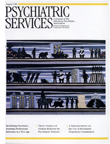State psychiatric hospital patients with past arrests for violent crimes
Abstract
OBJECTIVE: This study examined associations between four types of major psychopathology--schizophrenia, schizoaffective disorder, and bipolar and unipolar affective disorders--and history of violent crime. The effects of demographic variables, substance abuse, psychosis, and paranoia on history of violent crime were also determined. METHODS: Diagnostic assessments using the Schedule for Affective Disorders and Schizophrenia and Research Diagnostic Criteria identified 172 state hospital inpatients with the four diagnoses of interest, as well as those with co-existing substance use disorders. Based on arrest records, patients were categorized according to the most violent crime for which they had been arrested. RESULTS: Patients with schizoaffective disorder were significantly more likely than those in the other diagnostic groups to have been arrested for a violent crime. Similar results were found for psychotic patients compared with nonpsychotic patients, patients who had paranoid schizophrenia compared with patients who had schizophrenia without paranoid features, and patients who had co-existing substance abuse compared with those with no history of substance abuse. Patients from racial minority groups and male patients were also more likely than white patients and female patients to have been arrested for a violent crime. CONCLUSIONS: Demographic features, a diagnosis of schizoaffective disorder, psychosis, paranoid symptoms, and substance abuse may all be associated with violent behavior.
Access content
To read the fulltext, please use one of the options below to sign in or purchase access.- Personal login
- Institutional Login
- Sign in via OpenAthens
- Register for access
-
Please login/register if you wish to pair your device and check access availability.
Not a subscriber?
PsychiatryOnline subscription options offer access to the DSM-5 library, books, journals, CME, and patient resources. This all-in-one virtual library provides psychiatrists and mental health professionals with key resources for diagnosis, treatment, research, and professional development.
Need more help? PsychiatryOnline Customer Service may be reached by emailing [email protected] or by calling 800-368-5777 (in the U.S.) or 703-907-7322 (outside the U.S.).



